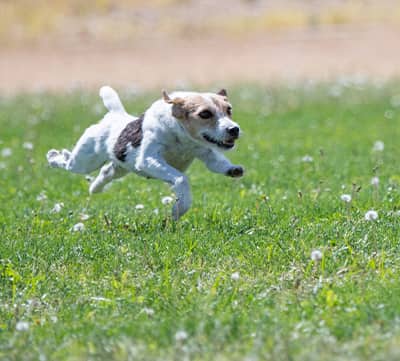A bluffer’s guide to the Lucky Dog Diet
Pressed for time but keen to understand the basics of the Lucky Dog Diet? Here is a summary of all its key elements.
Why some dogs can’t help piling on the pounds
As many as half the dogs in the UK are either overweight or obese. Why? Lack of exercise plays a role, but the main reason is modern dog food. Over the last few decades manufacturers have switched to a formula that is making it difficult for dogs to stay trim, namely: low levels of protein, high levels of simple carbohydrate and an excess of unhealthy fats. Yes, lots of dogs would benefit from additional exercise. Yes, there are dogs who, like Oscar Wilde, can resist anything but temptation (especially if the temptation comes in the form of treats and titbits). But the underlying problem is that modern dog food is fattening.
The quick, easy and pleasurable way for dogs to lose weight
The quick, easy and pleasurable way for dogs to lose weight is to switch from modern, processed dog food to the same sort of diet they ate before the dog food manufacturers grew to dominate the market. Such a diet is high in natural protein, low in carbohydrate and includes the right balance of ‘good’ fats. It’s the same diet that wolves eat in the wild. This is not a co-incidence! Dogs and wolves are so closely related that they can interbreed and possess identical digestive systems. Once dogs switch to a traditional, natural diet the weight falls off them, as if by magic. Best of all, they really love the food because it is full of extra flavour and texture.
Readily available ingredients
The Lucky Dog Diet requires very little preparation (literally a couple of minutes a day), the instructions are simple and all the ingredients you need are available from your supermarket or butcher. The main ingredients may surprise you – raw meat, raw bone and fresh vegetables – but when you think about what wolves and dogs eat in the wild, the rationale for the diet becomes apparent. The diet is suitable for any dog. What’s more, you’ll notice that the Lucky Dog Diet doesn’t require you to count calories. This is because the amount of food you feed your dog is based on his or her weight. Another thing, this diet leads to loss of unnecessary fat and not valuable muscle mass.
How to speed things up
The Lucky Dog Diet is much, much more effective when accompanied by an exercise programme. The best option is to get your dog out and about, but if this really isn’t feasible, don’t worry. There are ways of increasing the amount of exercise your dog receives without you having to leave home. For example, if you put a little bit of food into a Kong (a type of rubber toy) and play a game of fetch your dog will burn a surprising amount of calories. Exercise will improve your dog’s health, as well as his or her waistline, so it would be better to incorporate it into the Lucky Dog Diet. Still, just changing your dog’s diet will make a massive difference.
Long-term benefits of the Lucky Dog Diet
Having slimmed your dog down to the correct weight using the Lucky Dog Diet there is every reason to carry on feeding him or her the same diet. As those who have switched their dogs to a natural diet will testify, the results can be amazing. Benefits include a glossy coat, healthy skin, lean muscle tone, robust immune system, sweet-smelling breath, healthy teeth and gums, increased energy, better digestion and a strong heart. Dogs eating a natural diet can be expected to live longer and to suffer less illness and disease.
Why the Lucky Dog Diet is so effective
The reason why the Lucky Dog Diet is so effective is that it features what is generally referred to as a ‘biologically appropriate’ food. What does this mean? Each creature on earth needs a specific range of foods to survive and prosper. Otherwise, it will get ill and may (if the diet is really inappropriate) die. For the first 4 million years of dogs’ existence on earth they certainly didn’t eat canned food or kibble. Four million years? Yes, that’s how long wolves have been around, and dogs and wolves are classified as the same species. When wolves were domesticated (around 8,000 to 20,000 years ago), we humans changed their outer appearance through breeding, but not their internal organs or digestive systems.
In the wild, dogs eat prey and not much else
Dogs are carnivores (they do need a bit of herbage and if push comes to shove can survive on it) as even a cursory glance at their anatomy reveals. Like other predatory mammals, they have powerful muscles, fused wrist bones and a cardiovascular system that supports both sprinting and endurance. And there’s a reason why you don’t want to get bitten by a dog: their mouths are positive Swiss Army knives, with four kinds of exceedingly sharp teeth. Leave them to their own devices and they will eat small birds and beasts (rabbits, mice, squirrels &c.) and a share of larger prey (sheep, deer, boar &c.). What’s more, they eat the whole animal, including its bones.
Canine digestion is nothing like human digestion
Dogs have no digestive enzymes in their saliva (unlike humans) and very large, expandable stomachs (they can eat 5% of their bodyweight at a single sitting, which would be like someone who weighs 10 stone eating seven pounds of food in one go) not to mention indescribably strong stomach acids (strong enough to burn your fingers). Their digestive system is designed so that they can tear off chunks of raw meat, crunch up raw bones and swallow the lot whole. The lack of digestive enzymes in their saliva and their inability to move their jaws from side to side (necessary to grinding food) is why they gulp everything down. The entire digestive process takes place in their stomach.
Give a dog a bone
In the wild, up to a third of a dog’s nutrition (including calcium, magnesium, complex fats and vitamins) may come from bones. Bones keep their teeth and gums clean (it has been proven that dogs with healthy teeth live longer) and exercise their upper body and jaw. Providing the bones are raw (cooked bones can splinter) and certain basic rules are observed, they are 100% safe for dogs to eat.
What else is wrong with modern, processed dog food?
I have already explained how modern, processed dog food is contributing to our dogs’ weight issues. But it has other problems with it as well:
- It is cooked. Cooking destroys 70% of the nutritional value of the food from a dog’s perspective and makes it exceedingly difficult to digest.
- It can contain inappropriate and damaging chemicals (binders, colouring, preservatives and other additives). These may be absorbed through the bowel wall and transported to other organs, with a range of harmful effects.
- The quality of the ingredients is usually poor. Even expensive dog food often has very, very low-quality ingredients.
- Most dog foods contain a high percentage of grain (including rice), which is unsuitable for the canine digestive system and causes allergies.
- It generally fails to clean the dog’s teeth and gums, allowing plaque to build up. This gives rise to periodontal disease and worse.
Vicky Marshall
Author of the Lucky Dog Weight Loss Plan
For more information and advice on any aspect of canine health and nutrition please contact Honey’s – we’ll be happy to help even if you never, ever plan to become a customer.
Web: www.honeysrealdogfood.com
Email: info@honeysrealdogfood.com
Telephone: 01672 620 260







